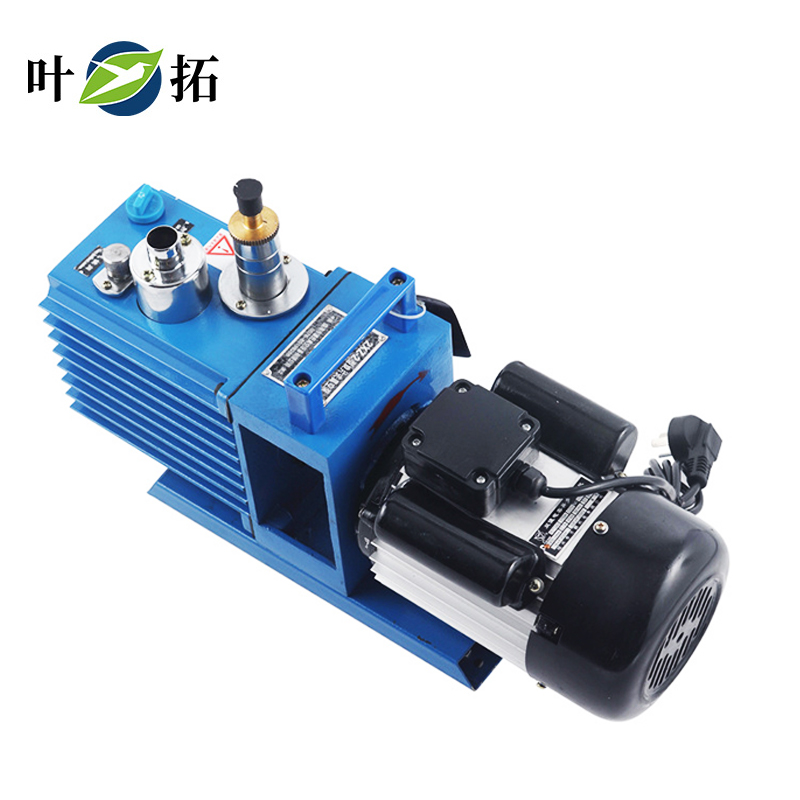
Structural description
Shanghai Yetuo rotary vane vacuum pump is a type of volumetric pump that uses rotary vanes to continuously operate in the pump chamber to suck in and compress gas, and finally discharge it through the exhaust port. The pump is mainly composed of stator, rotor, rotor, etc. The rotor is eccentrically installed in the stator cavity. There are two rotary blades in the rotor slot, and the rotary blade spring is placed between the two rotary blades. The intake and exhaust ports on the stator are separated into two parts by the rotor and rotor blades.
When the rotor rotates inside the stator cavity, the end of the rotor slides tightly against the inner wall of the pump cavity under the combined action of spring tension and its own centrifugal force, periodically expanding the volume of the cavity on the inlet side to suck in gas, while gradually reducing the volume of the exhaust port, compressing the already sucked in gas, and then discharging it from the exhaust port to achieve the purpose of pumping.
Characteristics and Scope of Application
characteristic:
The suction port of the vacuum pump is equipped with a coarse filter made of metal wire mesh. It can prevent solid foreign dust particles from being sucked into the pump chamber. An exhaust transition device with efficient oil and gas separation effect is installed inside the oil separator. When the pump is stopped, the suction valve built into the suction port isolates the pump from the pumped system, preventing oil from returning to the pumped system. The pump is cooled by air. All pumps of XD rotary vane vacuum pump are driven by directly connected electric motors through elastic couplings.
Scope of application:
1. Vacuum pumps are suitable for vacuuming in closed systems. Such as vacuum packaging, vacuum forming, and vacuum suction.
2. Inlet pressure range: 100Pa -100000 Pa, beyond this range, oil mist will be generated at the exhaust port of the working vacuum pump. The working environment temperature and suction gas temperature of XD rotary vane vacuum pump should be between 5 ℃ and 40 ℃.
3. Vacuum pumps cannot remove water or other liquids. Explosive, flammable, highly oxygenated, and corrosive gases cannot be extracted.
4. Generally supplied motors are not explosion-proof. If explosion-proof or other special requirements are required, the motor must comply with relevant standards.
working principle
Rotary vane vacuum pumps are mostly small and medium-sized vacuum pumps. There are two types of rotary vane vacuum pumps: single-stage rotary vane vacuum pumps and two-stage vacuum pumps. The so-called two-stage rotary vane vacuum pump is a structure that connects two single-stage pumps in series. Generally, it is made into a two-stage configuration to achieve a higher vacuum degree.
The relationship between the pumping speed and inlet pressure of a rotary vane vacuum pump is specified as follows: at inlet pressures of 1333Pa, 1.33Pa, and 1.33 × 10-1 (Pa), the pumping speed values shall not be lower than 95%, 50%, and 20% of the nominal pumping speed of the pump, respectively.
Figure 2 shows the working principle of a two-stage pump, which consists of two single-stage pumps connected in series. When working, the extracted gas first enters the high vacuum stage through the suction cylinder. When the pressure of the inhaled gas is high, a portion of the gas is discharged through exhaust valve 2, while another portion of the gas passes through the low vacuum stage and is discharged through exhaust valve 1. When the pressure of the inhaled gas is low, although it is compressed by the high vacuum stage, exhaust valve 2 still cannot open for exhaust, and can only continue to compress through the low vacuum electrode and be discharged by exhaust valve 1, because the ultimate vacuum of the two-stage pump is higher than that of the single-stage pump.
application
Widely used in production and research departments such as metallurgy, machinery, military industry, electronics, chemical industry, light industry, petroleum, and medicine. It has been widely used in vacuum packaging of food and vacuum forming of plastic industry. Paper conveying, vacuum fixtures, and vacuum suction in the printing industry.
Maintenance methods
Regularly check the oil level and contamination (recommended once a week). If the oil level is too low, stop the rotary vane vacuum pump and add suitable vacuum pump oil to 4/5 of the oil window height. If the oil is contaminated, it will turn black, emulsify, or thicken, and should be replaced in a timely manner.
Replace the vacuum pump oil and oil filter:
It is recommended to change the oil of the rotary vane vacuum pump after the first 150 hours of operation. Change the oil every 500 hours of work in the future. At the same time as changing the oil, the oil filter should be replaced. If the oil becomes black, emulsified, or thickened due to contamination, it should be replaced in a timely manner. And clean the pump before adding new oil.
Cleaning and oil change steps:
1. Stop the rotary vane vacuum pump and release the hot oil.
2. Turn on the drain plug and run for 5-10 seconds.
3. Drain the oil completely.
4. Inject cleaning oil to 3/4 of the height of the oil window.
5. Run the rotary vane vacuum pump for 5-10 minutes.
6. Stop the pump and drain the oil. If the oil still cannot meet the requirements, repeat steps 4 and 5.
7. Turn on the drain plug and run 5-10 notes.
8. Drain the oil completely.
9. Inject the specified new rotary vane vacuum pump oil.


